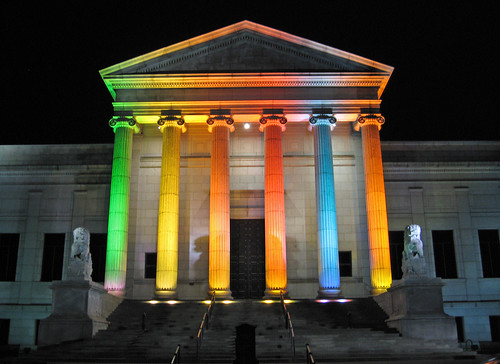The Minneapolis Institute of Arts (MIA) is an encyclopedic fine art museum located in the Whittier neighborhood of Minneapolis, Minnesota on a campus that covers nearly 8 acres (32,000 m²) which was formerly Morrison Park. It does not charge an entrance fee (although it does charge for some special exhibitions), and allows photography of its permanent collection for personal use only. The museum receives support from the park board museum fund, levied by the Hennepin County commissioners.
History
Growing out of a perceived lack of fine arts in the Minneapolis area, the first meeting of what became the Minneapolis Society of Fine Arts took place in 1883. This group, made up of business and professional leaders of the time, organized art exhibits throughout the decade. In 1889, the Society, now known as the Minneapolis Institute of Arts, moved into its first permanent space inside the newly built Minneapolis Public Library.
A new museum building, designed by the firm of McKim, Mead and White, opened its doors in 1915. Built on land donated by the Morrison family formerly occupied by their Villa Rosa mansion, the museum came to be recognized as one of the finest examples of the Beaux-Arts style of architecture in Minnesota. Art historian Bevis Hillier organized an exhibition called Art Deco at the MIA that took place from July to September 1971, which caused a great resurgence of interest in this style of art. The building was originally meant to be the first of several sections but only this front piece was ultimately built; several additions have subsequently been built according to other plans, including a 1974 addition by Kenzo Tange. An expansion designed by Michael Graves was completed in June of 2006.
The building is located within the Washburn-Fair Oaks Mansion District, a neighborhood of mansions built by wealthy Minneapolis business leaders between 1880 and 1920. The district is listed in the National Register of Historic Places.
Collections
The MIA features an encyclopedic collection of approximately 80,000 objects spanning 5,000 years of world history. Its collection includes paintings, photographs, prints & drawings, textiles, architecture, and decorative arts. Thee are collections of African art and art from Oceania and the Americas, and an especially strong collection of Asian art, called "one of the finest and most comprehensive Asian art collections in the country". The Asian collection includes Chinese architecture, jades, bronzes, and ceramics.
The largest item in the collection is the Purcell-Cutts House, one of the most significant examples of Prairie School architecture. The MIA restored the house at its original address and opened it to the public in 1990.
Services
In order to encourage private collecting and assist in the acquisition of important works of art, the museum has created “Curatorial Councils” aligned with the seven curatorial areas of the museum. The councils schedule lectures, symposia, and travel for members.
The MIA features a regular series of exhibitions that bring in traveling collections from other museums for display. Local business partners fund many of these exhibitions and some feature the artists themselves leading public tours through the exhibition.
The MIA also houses the Minnesota Artists Exhibition Program (MAEP). The MAEP is an artist-controlled program devoted to the exhibition of works by artists who live in Minnesota














No hay comentarios:
Publicar un comentario